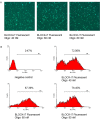siRNA Targeting the 2Apro Genomic Region Prevents Enterovirus 71 Replication In Vitro
- PMID: 26886455
- PMCID: PMC4757562
- DOI: 10.1371/journal.pone.0149470
siRNA Targeting the 2Apro Genomic Region Prevents Enterovirus 71 Replication In Vitro
Abstract
Enterovirus 71 (EV71) is the most important etiological agent of hand, foot, and mouth disease (HFMD) in young children, which is associated with severe neurological complications and has caused significant mortalities in recent HFMD outbreaks in Asia. However, there is no effective antiviral therapy against EV71. In this study, RNA interference (RNAi) was used as an antiviral strategy to inhibit EV71 replication. Three small interfering RNAs (siRNAs) targeting the 2Apro region of the EV71 genome were designed and synthesized. All the siRNAs were transfected individually into rhabdomyosarcoma (RD) cells, which were then infected with strain EV71-2006-52-9. The cytopathic effects (CPEs) in the infected RD cells, cell viability, viral titer, and viral RNA and protein expression were examined to evaluate the specific viral inhibition by the siRNAs. The results of cytopathogenicity and MTT tests indicated that the RD cells transfected with the three siRNAs showed slight CPEs and significantly high viability. The 50% tissue culture infective dose (TCID50) values demonstrated that the viral titer of the groups treated with three siRNAs were lower than those of the control groups. qRT-PCR and western blotting revealed that the levels of viral RNA and protein in the RD cells treated with the three siRNAs were lower than those in the controls. When RD cells transfected with siRNAs were also infected with strain EV71-2008-43-16, the expression of the VP1 protein was significantly inhibited. The levels of interferon α (IFN-α) and IFN-β did not differ significantly in any group. These results suggest that siRNAs targeting the 2Apro region of the EV71 genome exerted antiviral effects in vitro.
Conflict of interest statement
Figures








Similar articles
-
The highly conserved 5' untranslated region as an effective target towards the inhibition of Enterovirus 71 replication by unmodified and appropriate 2'-modified siRNAs.J Biomed Sci. 2012 Aug 13;19(1):73. doi: 10.1186/1423-0127-19-73. J Biomed Sci. 2012. PMID: 22889374 Free PMC article.
-
RNA interference against enterovirus 71 infection.Virology. 2005 Oct 10;341(1):72-9. doi: 10.1016/j.virol.2005.06.047. Virology. 2005. PMID: 16083932
-
Enhanced potency and efficacy of 29-mer shRNAs in inhibition of Enterovirus 71.Antiviral Res. 2007 Apr;74(1):9-15. doi: 10.1016/j.antiviral.2007.01.004. Epub 2007 Jan 31. Antiviral Res. 2007. PMID: 17316836
-
Recent Progress on Functional Genomics Research of Enterovirus 71.Virol Sin. 2019 Feb;34(1):9-21. doi: 10.1007/s12250-018-0071-9. Epub 2018 Dec 14. Virol Sin. 2019. PMID: 30552635 Free PMC article. Review.
-
[Research into the Pathogenicity of Enterovirus 71].Bing Du Xue Bao. 2015 Mar;31(2):192-6. Bing Du Xue Bao. 2015. PMID: 26164947 Review. Chinese.
Cited by
-
Antivirals and vaccines for Enterovirus A71.J Biomed Sci. 2019 Sep 3;26(1):65. doi: 10.1186/s12929-019-0560-7. J Biomed Sci. 2019. PMID: 31481071 Free PMC article. Review.
-
Innate Immunity Evasion by Enteroviruses Linked to Epidemic Hand-Foot-Mouth Disease.Front Microbiol. 2018 Oct 8;9:2422. doi: 10.3389/fmicb.2018.02422. eCollection 2018. Front Microbiol. 2018. PMID: 30349526 Free PMC article. Review.
-
Analysis of miRNAs Involved in Mouse Brain Damage upon Enterovirus 71 Infection.Front Cell Infect Microbiol. 2017 Apr 19;7:133. doi: 10.3389/fcimb.2017.00133. eCollection 2017. Front Cell Infect Microbiol. 2017. PMID: 28469998 Free PMC article.
-
Cathepsin S Alters the Expression of Pro-Inflammatory Cytokines and MMP-9, Partially through Protease-Activated Receptor-2, in Human Corneal Epithelial Cells.Int J Mol Sci. 2018 Nov 9;19(11):3530. doi: 10.3390/ijms19113530. Int J Mol Sci. 2018. PMID: 30423938 Free PMC article.
-
Role of Non-Coding RNA in Neurological Complications Associated With Enterovirus 71.Front Cell Infect Microbiol. 2022 Apr 25;12:873304. doi: 10.3389/fcimb.2022.873304. eCollection 2022. Front Cell Infect Microbiol. 2022. PMID: 35548469 Free PMC article. Review.
References
MeSH terms
Substances
Grants and funding
LinkOut - more resources
Full Text Sources
Other Literature Sources
Miscellaneous

